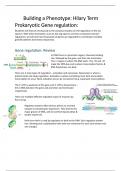Class notes
Hilary term: Building a Phenotype Lecture Notes
- Course
- Institution
Contains the following lecture notes: 1. Prokaryotic Gene regulation: 2. Prokaryotic cell structure & function: 3. Control of prokaryotic growth: 4. Prokaryotic genomes & cell division: 5. Introduction to the organelles of the eukaryotic cell: 6. Eukaryotic cell biology: the endomembrane syst...
[Show more]



